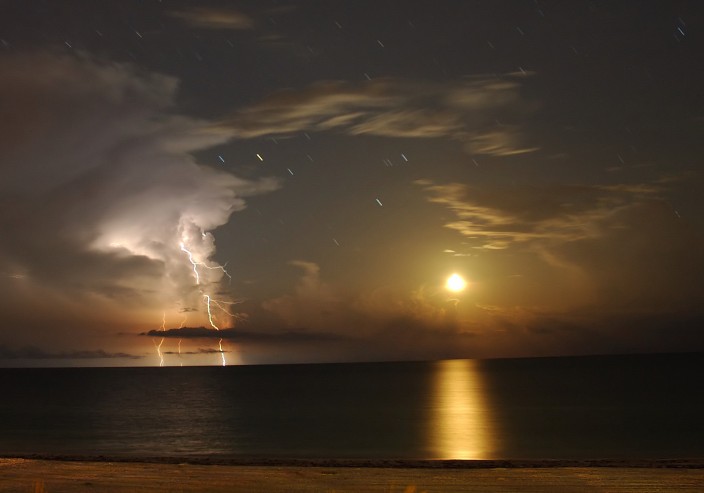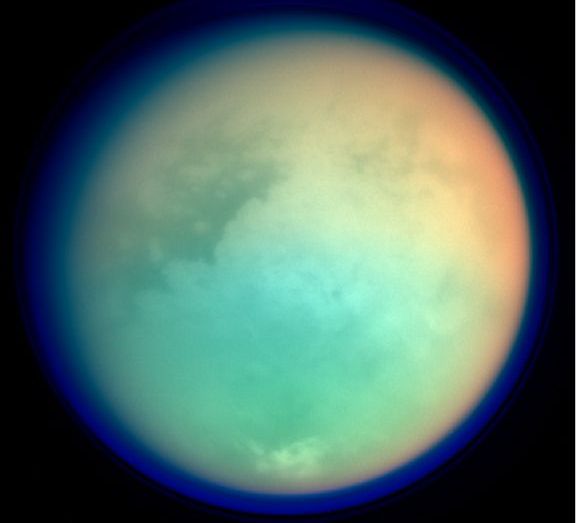Posted by axxxr
Astronomy Picture of the Day (makes a nice wallpaper)

Explanation: Moonsets are not often quite as exciting as this one. But amateur astronomer Marc-Andre Besel was impressed by the brilliant lighting displays that joined the first quarter Moon and stars of the constellation Scorpius in western skies. On August 22, 2004, his view looked across the Gulf of Mexico from Anna Maria Island, Florida, USA, a region that would experience even more stormy weather in the coming days. The alluring digital image is a time exposure, by chance capturing the details of a brief flash of lightning along with an overexposed Moon and dramatic cloud formations. In fact, the exposure is long enough to show the background stars as short streaks or trails. The bright yellowish star trail, just above and right of the lightning flash, is red giant star Antares.
Posted by Sammy_boy
Nice picture, Axxxr!
Posted by whizkidd
Good to see this thread still alive. Sam, are you here? :-D
Posted by mince-inside
With my spare time I decided to buy a telescope with a cool thermal printer, however, this morning I found this in the output tray and I was sure I switched it all off last night!
Any ideas as to the constellation?
Posted by axxxr
Here's a beautiful picture of titan.

Posted by whizkidd
Thanks axxxr! Sam where art thou dude? Its approaching winter time here. I bet its a good time for some serious stargazing.
Posted by Sammy_boy
Still here!
Yep, winter's coming now, and when I look up when it's clear the night sky is nice and crisp and clear, less problems with the atmospheric 'seeing' causing problems.
Posted by whizkidd
My exams are going on right now. After i'm finished with them, i will be doin quite a bit of astronomy. But right now i'm posting with a mathematics textbook in my hand! :-D
Posted by Sammy_boy
Yes, I know that feeling. I'm a bit pushed to time at the moment too, espeically as I've just failed 2 of 3 assignments I've just handed in
I try to sometimes at least pop outside with a pair of binoculars, I do quite like binocular astronomy, it's nice to use both eyes to stargaze with.
Posted by kristaga
I took this photograph of the lunar eclipse early Thurday morning:

It is taken a bit before the Moon was totally eclipsed.
Posted by kristaga
Carsten Arnholm from the Norwegian astronomical society filmed the eclipse:
http://arnholm.org/astro/moon/eclipse_20041028_divx.avi
Posted by whizkidd
Hey! Thanks Kris!
Posted by kristaga
Who is Kris?
Posted by whizkidd
This one is in urgent need of CPR!!
Posted by twerg
Just scored myself a free dvd from New Scientist Magazine all about the past 15 years of the Hubble Space Telescope. Awesome viewing. 40000 copies were to be given away, not sure if any left.... Crystal clear sight of the night sky here in Tasmania, Australia. I have no telescope or binocular's unfortunately. Not quiet astronomy but we also get some quite amazing aroura's here too.
Posted by axxxr
Here's a free space simulation that lets you explore our universe in three dimensions.
Unlike most planetarium software, Celestia doesn't confine you to the surface of the Earth. You can travel throughout the solar system, to any of over 100,000 stars, or even beyond the galaxy.
All movement in Celestia is seamless; the exponential zoom feature lets you explore space across a huge range of scales, from galaxy clusters down to spacecraft only a few meters across. A 'point-and-goto' interface makes it simple to navigate through the universe to the object you want to visit.
Celestia is expandable. Celestia comes with a large catalog of stars, planets, moons, asteroids, comets, and spacecraft. If that's not enough, you can download dozens of easy to install add-ons with more objects.
http://celestia.sourceforge.net/
Posted by gelfen
Jupiter will be visible during the day in parts of eastern Australia this afternoon.
Stargazers prepare for daylight view of Jupiter

Jupiter will be visible with the naked eye this afternoon. (Reuters)
The planet Jupiter will be visible with the naked eye this afternoon, appearing as a point of light in the eastern sky just below the moon.
Nick Lomb, curator of astronomy at the Sydney Observatory, says the best time for people on the east coast to see the planet is about 4:00pm AEST; it will be visible a bit later elsewhere in Australia.
Dr Lomb says it is best to view the planet using binoculars or a small telescope.
"People forget that stars and planets are actually there, they don't actually go away to hide during the day, they are there, but it's just hard to find [them] in the glare of sunlight," he said.
"But this will give us an opportunity to find Jupiter in the sky."
In areas north of Brisbane, including Rockhampton and Townsville, Jupiter will disappear behind the moon in what is known as an occultation.
"If people are watching with a pair of binoculars or a small telescope, they'll actually see Jupiter disappear as the moon moves in front of it," he said.
"It will disappear on the dark side of the moon."
Dr Lomb says people in Brisbane will see Jupiter almost disappear, in what is called a grazing occultation.
He says the phenomenon, which has not happened for a few years, is caused when the moon moves between Jupiter and earth.
People south of Brisbane will be able to see Jupiter as a bright point of light in the sky.
© 2005 ABC
Jupiter to be visible in daytime
June 15, 2005 - 12:24PM
Casual skywatchers in eastern Australia will get a rare opportunity to see the giant planet Jupiter during daylight on Thursday.
Canberra-based science teacher Paul Floyd said this was because the moon would be close to Jupiter's position in the sky for a short period.
Mr Floyd said the best view of the event, known as a grazing occultation, would occur in Brisbane about 4pm (AEST) when the moon would appear to slice the planet in half.
He said that north of Brisbane the planet would disappear behind the moon in a full occultation, while watchers in Sydney, Canberra and Melbourne would see the moon pass just below Jupiter.
Mr Floyd said the event gave casual observers their best chance to see the planet because usually they had little idea precisely where to look, and many believed it was impossible to see the planet in the daytime.
"The problem with doing this usually is that your eyes don't have anything to focus on.
"Having the moon near Jupiter gets around this problem, plus giving you a sort of signpost to locate Jupiter with," he said.
Mr Floyd said people could watch the event with the unaided eye, although the best view would be obtained with a small telescope or binoculars after locating the moon above the eastern horizon at around 3.30pm (AEST).
© 2005 AAP
Chance to see Jupiter in daytime
June 15, 2005
PEOPLE in eastern Australia will have a rare chance to see the giant planet Jupiter tomorrow when the moon moves between the giant planet and earth.
Canberra science teacher Paul Floyd said the best view of the event, known as a grazing occulation, would occur in Brisbane at around 4pm (AEST) when the moon would appear to slice the planet in half.
He said that north of Brisbane the planet would disappear behind the moon in a full occulation, while watchers in Sydney, Canberra and Melbourne would see the moon pass just below Jupiter.
Mr Floyd said people could watch the event with the unaided eye, although the best view would be obtained with a small telescope or binoculars after locating the moon above the eastern horzon at around 3.30pm (AEST).
© The Australian
_________________
Whomsoever you see in distress, recognize in him a fellow man
Gelfen's special place where people talk to him
[ This Message was edited by: gelfen on 2005-06-16 05:11 ]
Posted by paulbang
The moon will also be visible tonight. Watch the moon with the naked eye tonight once the sun has set. In some places the moon won't be visible, thats because it changes its position once a month, it will be there over your sky eventually. In other places only half of the moon can be seen.thats because the hubble telescope blocks out the they sometimes and mostly this is caused due to low bandwidth in your areasPlease contact me paul for more news on the moon
Posted by axxxr
Here is an amazing picture of a frozen ice lake on mars:
Mars Express
Posted by JK
Is there water on Mars??
Posted by axxxr
Just frozen lakes no actual water found yet!....but scientists say their maybe water rivers under the surface of mars.
Posted by etaab
But isnt a frozen lake simply water ?
That site link says its certainly water, and if it is, theres a good chance there could be life on Mars however primitive it is !
Posted by axxxr
Here's an amazing picture of Earth as seen from Mars...really shows how tiny and insignificant we are in the universe...all i can just say is WOW!!
NASA
That tiny bright dot in the centre is us!
On its 449th martian day, or sol (April 29, 2005), NASA's Mars rover Opportunity woke up approximately an hour after sunset and took this picture of the fading twilight as the stars began to come out. Set against the fading red glow of the sky, the pale dot near the center of the picture is not a star, but a planet -- Earth.
Earth appears elongated because it moved slightly during the 15-second exposures. The faintly blue light from the Earth combines with the reddish sky glow to give the pale white appearance.
Posted by Sammy_boy
Wow, great picture!
Shame more people don't realise how small and insignificant we really are in the grand scheme of things, the world would be a more thoughtful, and peaceful place I'm certain!
Posted by axxxr
Hubbles images of a exploding star:
Posted by gelfen
via Space.com
| Quote: |
Nine Planets Become 12 with Controversial New Definition |
_________________
Whomsoever you see in distress, recognize in him a fellow man
Gelfen's special place where nobody talks to him anymore
[ This Message was edited by: gelfen on 2006-08-18 04:40 ]
Posted by govigov
Posted by Sammy_boy
Think it was a lot simpler with just the 9 planets, playing about with the definition of a planet and classifying large asteroids and moons as planets would be silly. Does this mean they'll be classifying Jupiter and Saturn's moons as planets too?



